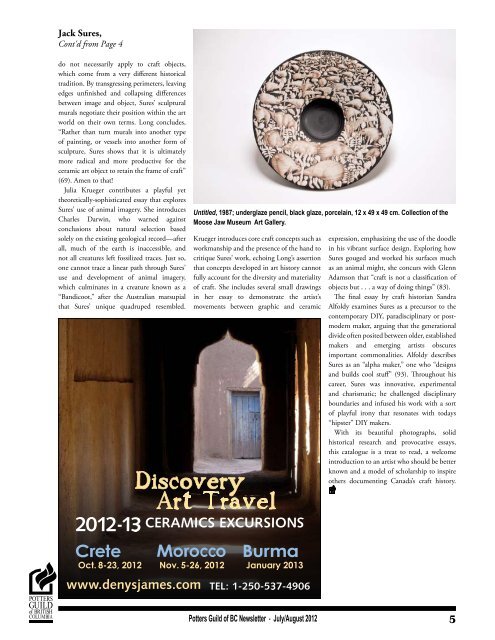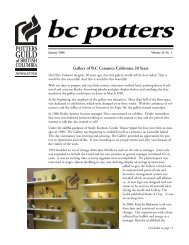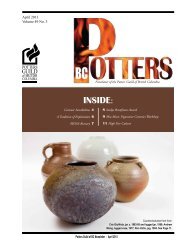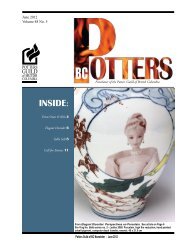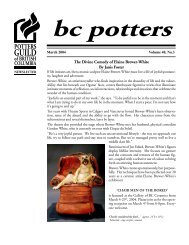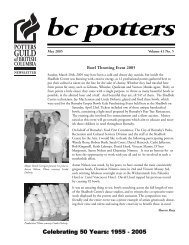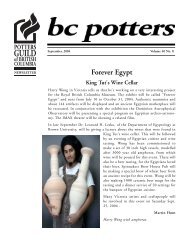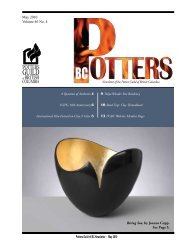Tactile Desires: The Work <strong>of</strong> Jack Sures By Amy GogartyHand Built Pot, 1968; oxides, fibreglassstoneware, 59.5 x 60 x 60 cm. SaskatchewanArts Board Permanent Collection.The Answer, 1987; sprayed engobe,stoneware tiles, 235 x 197 x 5.7. Collection <strong>of</strong>Jack Sures and Cara Gay Driscoll.Catalogue <strong>of</strong> the exhibition at the MacKenzieArt Gallery, Regina, Sask., 24 September2011 – 2 January, 2012, travelling to OwenSound and beyond. Available from theMacKenzie for $44.95 plus tax and shippingfrom galleryshop@mackenzieartgallery.ca or306.584.4270.The work <strong>of</strong> Regina clay artist Jack Suresis not as well-known as it should be here onthe west coast, but in Regina, Sures is a majorfigure whose influence extends through histeaching, public commissions, elegant ceramicvessels and graphic works. The MacKenziehas assembled an impressive selection <strong>of</strong>107 vessels, platters, decorated tiles andgraphic works dating from 1964 through to2010, accompanying this with a beautifullyillustrated catalogue with essays by curatorVirginia Eichhorn, associate curators JuliaKrueger and Timothy Long, craft historianSandra Alfoldy and Seattle art critic MatthewKangas. For those unfamiliar with Sures, thecatalogue provides an excellent introductionto his work, and for those interested incontemporary ceramic criticism, history andtheory, it <strong>of</strong>fers much to consider.Born to Russian Jewish immigrants in 1934,Sures was raised partly by his grandparents inWinnipeg, where he was first exposed to artsand crafts classes. After entering universityto study science, he switched to fine arts,supporting himself in school by workingon the railway. He travelled extensively,working his way across Britain, Europe, theMiddle East and Israel. In 1972, he travelledto Grenada with the United Nations andset up a ceramics program that is still inoperation. For thirty-two years he taught atthe University <strong>of</strong> Regina, where he mentoredseveral generations <strong>of</strong> ceramists. Sures was akey factor in the Regina Clay movement anddid much to maintain a dialogue betweenRegina and California. He is known for hislarge thrown and textured vessels, many<strong>of</strong> which feature animal imagery as surfacedecoration or ornamental additions, and forhis architectural murals that appear on publicbuildings such as the Canadian Museum <strong>of</strong>Civilization across Canada.Tactile Desires is a model <strong>of</strong> clarity with itsorderly presentation <strong>of</strong> a detailed chronology,bibliography and handsome photography.The list <strong>of</strong> works provides comprehensiveinformation on medium, size, collection andpage on which the work is reproduced. Onemight think this is stating the obvious, but,unfortunately, all too many publications missthe opportunity to organize and present thisinformation in a practical manner. This alonewould establish the value <strong>of</strong> this catalogue,yet, thankfully, there are also five essays toenlighten and challenge the reader.Curator Virginia Eichhorn outlines theprimary events and influences in Sures’life and work, exploring issues such as theeroticism and sensuality in his work. She seesthese as factors reflecting changing sexualmores in Canada, the artist’s three marriagesand his remarkable physical energy. Eichhorncalls Sures “an unrepentant sensualist” andhis work “the physical manifestation <strong>of</strong> histactile desires” (27). Seattle critic MatthewKangas places Sures’ work in an internationalcontext, stressing the emergence post-WWII<strong>of</strong> a “global ethic <strong>of</strong> the handmade...hybridblends <strong>of</strong> the internationally informed craftobject” (43). Travel and extended stays inGreat Britain, France, Japan and the UnitedStates introduced Sures to an internationalcommunity <strong>of</strong> artists and world art traditions.Living in Regina, he encountered thefamous Emma Lake Artists’ Workshops andAmerican legends Clement Greenberg andJohn Cage. As the ceramic program expandedin Regina, it attracted students and pr<strong>of</strong>essorsfrom across North America, notably thehyper-realist ceramic sculptor MarilynLevine and the California Funk artist DavidGilhooly. As Kangas details, these influencescreated an extremely fertile and sophisticatedenvironment in Regina, encouraging thecreation <strong>of</strong> work that was outward-lookingand world-class in stature.Timothy Long focuses on Sures’ large-scalepublic murals. Exploring the art/craft debatewith fresh insight and relating anecdotesdrawn from his experience as a curator, Longtells a story in which he puzzled over theorientation <strong>of</strong> what he called an “ugly” potfrom the late 1960s. Years later, he discoveredthe so-called sculpture was actually a hangingplanter missing its rope. He uses this anecdoteto explore the variety <strong>of</strong> “frames” that havebeen applied to Sures’ work over the yearsand to question issues <strong>of</strong> boundaries betweenart and craft. Long argues that the “framingdevices” developed to discuss artworksContinued on Page 5, Jack Sures<strong>Potters</strong> <strong>Guild</strong> <strong>of</strong> <strong>BC</strong> Newsletter . July/August 20124
Jack Sures,Cont'd from Page 4do not necessarily apply to craft objects,which come from a very different historicaltradition. By transgressing perimeters, leavingedges unfinished and collapsing differencesbetween image and object, Sures’ sculpturalmurals negotiate their position within the artworld on their own terms. Long concludes,“Rather than turn murals into another type<strong>of</strong> painting, or vessels into another form <strong>of</strong>sculpture, Sures shows that it is ultimatelymore radical and more productive for theceramic art object to retain the frame <strong>of</strong> craft”(69). Amen to that!Julia Krueger contributes a playful yettheoretically-sophisticated essay that exploresSures’ use <strong>of</strong> animal imagery. She introducesCharles Darwin, who warned againstconclusions about natural selection basedsolely on the existing geological record—afterall, much <strong>of</strong> the earth is inaccessible, andnot all creatures left fossilized traces. Just so,one cannot trace a linear path through Sures’use and development <strong>of</strong> animal imagery,which culminates in a creature known as a“Bandicoot,” after the Australian marsupialthat Sures’ unique quadruped resembled.Untitled, 1987; underglaze pencil, black glaze, porcelain, 12 x 49 x 49 cm. Collection <strong>of</strong> theMoose Jaw Museum Art Gallery.Krueger introduces core craft concepts such asworkmanship and the presence <strong>of</strong> the hand tocritique Sures’ work, echoing Long’s assertionthat concepts developed in art history cannotfully account for the diversity and materiality<strong>of</strong> craft. She includes several small drawingsin her essay to demonstrate the artist’smovements between graphic and ceramicexpression, emphasizing the use <strong>of</strong> the doodlein his vibrant surface design. Exploring howSures gouged and worked his surfaces muchas an animal might, she concurs with GlennAdamson that “craft is not a classification <strong>of</strong>objects but . . . a way <strong>of</strong> doing things” (83).The final essay by craft historian SandraAlfoldy examines Sures as a precursor to thecontemporary DIY, paradisciplinary or postmodernmaker, arguing that the generationaldivide <strong>of</strong>ten posited between older, establishedmakers and emerging artists obscuresimportant commonalities. Alfoldy describesSures as an “alpha maker,” one who “designsand builds cool stuff” (93). Throughout hiscareer, Sures was innovative, experimentaland charismatic; he challenged disciplinaryboundaries and infused his work with a sort<strong>of</strong> playful irony that resonates with todays“hipster” DIY makers.With its beautiful photographs, solidhistorical research and provocative essays,this catalogue is a treat to read, a welcomeintroduction to an artist who should be betterknown and a model <strong>of</strong> scholarship to inspireothers documenting Canada’s craft history.CreteMoroccoBurmaOct. 8-23, 2012 Nov. 5-26, 2012 January 2013<strong>Potters</strong> <strong>Guild</strong> <strong>of</strong> <strong>BC</strong> Newsletter . July/August 20125


